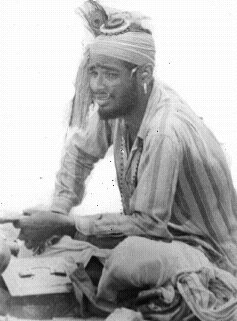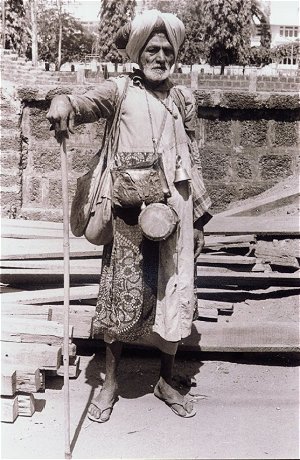The Begging Profession
by K. L. Kamat
Translated from Kannada original Bhikshatane. Published
in "Mallige" Monthly
First
Online: August 15, 1997
Page Last Updated:
December 07, 2024
Leadership | Love Life
© K. L. Kamat

Blind man playing flute through nose
Beggar on a Bangalore street, India, 1991
It is believed in India that Lord Shiva (topics -
pictures) once ran his household by a mere income of
scalping collected
by begging among rishis and sadhus. Have the times changed!
Now it is extremely difficult even for full time beggars (panhandlers) to make good of two
meals. Not so long ago in India, on Saturdays and Mondays every beggar who showed up at the door
was given a measure of rice or juvar. The guru-bhakta who went worshiping to the
temple on Thursdays, got a handful of goodies and money. The beggar community feels that
due to the increase in mankind's selfishness and small-mindedness, they are not able to
make a living. The government through its policies has not helped them either. "Like
prostitution, begging is oldest profession on earth. Although varying by geography
and the times, begging is universal. We have heard that even richest countries like
America have beggars in one form or another," is the argument of the beggars.
The intellectuals for long have been intrigued by mankind's attraction to living by panhandling. Why do able bodied, working people take up begging? Why do Bengali refugees return to starving Bengal after assisted relocation? Why have we failed to settle vagabond tribes like the Bhils and Mogalayas?
It is not easy to give up the skills of earning a livelihood. Even if you protect a prostitute in an ashram, the social reformers opine that she does not forget her easy life and in some form or another resumes old habits. Similarly I'm not surprised at the attitude of the officials of the "Panhandling Elimination Department", which is one of apathy and lacking sincerety.
 It is very difficult to generalize how and where panhandling begins
in the life of a beggar. Some inherited from their
ancestors. There are all kinds of beggars whose period of begging spans from five minutes
to fifty years. A boy was begging for peanuts on the street, but when
someone offered him money, he refused. "I
like peanuts," he said ran away - his needs being very specific. The eight year old of a
maid-servant who was instructed to play outside was begging the passers by for small
change and bought candy. When I asked a strongly built man why he couldn't work, I was
told that he was merely continuing his family tradition!
It is very difficult to generalize how and where panhandling begins
in the life of a beggar. Some inherited from their
ancestors. There are all kinds of beggars whose period of begging spans from five minutes
to fifty years. A boy was begging for peanuts on the street, but when
someone offered him money, he refused. "I
like peanuts," he said ran away - his needs being very specific. The eight year old of a
maid-servant who was instructed to play outside was begging the passers by for small
change and bought candy. When I asked a strongly built man why he couldn't work, I was
told that he was merely continuing his family tradition!
Generally, the elderly, the disabled, and the unemployed take to begging. Folks who were robbed during their pilgrimage, temporarily beg to return home. The lepers and destitute graduate to this profession. From beggars who cry in front of you asking for food to entertainers who beg with the help of pets and children, most homeless fall into the category of beggars with more or less the same yard stick.
Just like lawyers, administrators and athletes, the beggars can be very professional. They guard their constituencies with great care. It is common to fight over territories. The beggar who beggars in front of Ganesh hotel cannot go and beg in front of Krishna hotel! When an unassuming new comer from a village stuck out his hand in front of the temple, he was chased away and had to go to Saibaba ashram for shelter. Although the beggars do not have an association or union, they unite to defend their sources of income.
© K. L. Kamat

A Fortuneless Fortune Teller
While the beggars of the temples, churches, and mosques need not travel, the beggars of shops and households have to wander a lot. The beggars have to care about their attire just like actors and performers. People who beg in the name of the religion have to grow beard, wear saffron (kavi) clothes and ash. The fortune teller Bhils wear peacock feathers and other make-ups. The Budabudakis who do not know about their next meal, but can tell customers what lies in the decades to come wear Zari Rumal, and apply ash on the forehead to give them a holy look. Devadasis (temple women -- see The Temple Women of India) wear turmeric powder, flowers, and kumkum. The transvestites (impotent men dressed as women) have altogether different, yet distinct style. They are clean shaven and apply fashionable cosmetics. They have acquired artificial feminine postures and dances. The beggars who use animals for fund raising have to decorate their pets, too. They have to buy caps for the monkey, jingle bells for the cow, and decorative clothing for the bull.
© K. L. Kamat

Beggar by choice: A Sufi fakir seeks alms on the street
The beggars have to master the art of begging just as they have to master the art of dressing up. They realize that it is very difficult to refuse a hungry man begging just as you come out of a popular restaurant. While a woman begs in the name of her husband who is in the death bed in a hospital, it is not uncommon that the husband is begging in his wife's name on the next street. A pregnant woman will say that her previous child has died, and she needs money for the funeral. Her heart-rendering appeal fetches good money, yet nobody knows if any of her six children has died. An entire family will beg saying they lost everything in the floods. The children and women in scanty clothing will be sleeping on the road side and the head of the household blocks the passers-by for small change.
© K. L. Kamat

Attire of a Professional Beggar
Notice his drums and bells. He's carrying everything that he owns.
The beggars are fairly well-organized although they not unionized. They view new beggars with suspicion and try to find out his/her depth by typical questionnaires. They have a means of estimating and budgeting income and expenses. A small town beggar has a hard time to raise two to three Rupees per day while a city beggar can easily earn ten bucks. During the festivals, they could earn as much as thirty Rupees (the time of this writing). For commoners, this may look like a paltry sum, but we have to understand that the beggars do not have any expenses. No rent, no groceries to buy. The leftovers from the restaurants is their dinner; else every beggar typically has a godmother who never refuses food for him/her. The roadside food courts typically provide discount prices to beggars. They travel in buses which have friendly conductors, without tickets and they always know that temples/churches/railway stations can be used for toilet and sleeping. Since they do not have a safe place to keep money, they carry with them all the time. I know of an old beggar lady who passed away and they found her shawl embedded with currency notes which amounted to two thousand rupees.
© K. L. Kamat

A beggar at the Mangeshi temple, Goa
The beggars need protection just like everyone. They especially need protection of their savings and begging zones. Often there are these self-style beggar leaders who enforce the rules. There is no rule to pay him money for his leadership. You can provide a hot cup of coffee once in a while. There are even beggar gangs whose leader takes a bigger share, but distributes among the members. The team of blind men and the team of transvestites belong to this category. The beggars at the railway stations and bus stands are usually dominated by thugs who run begging rackets. There are these goondas who liberate beggars from rehabilitation centers and send them back to the streets for begging.
The beggars never make short of their love life. They tie a sari across in the choultry and convert it into a bedroom. Like western cultures, they have complete equality of sexes in the beggar community and the woman can choose and change her partners. When husband and wife go begging separately, sometimes they run away with their other lovers. Many times the husband goes after his wife whom he misses a lot. There was a husband who cut off his wife's nose so she doesn't run away again. The children become independent by the time they are eight. In addition to begging, they take to pick-pocketing, stealing of shoes in temples, and petty thefts at the market place. Many professional thieves hire the beggar children as their assistants, informants, and to peddle stolen goods. If the police catch these kids, they are sent to government remand homes or religious centers, but it is not of much use. They have to take to the streets as that is only means of survival.
The beggar colonies are breeding grounds for the anti-social elements. They live a very unhygienic life style, cooking, sleeping, and defecating in the same area. In our society most people give to beggars more to earn punya (divine credits) rather than out of feelings for the beggar. It is not uncommon to see a housewife toss a coin through a window to the beggar after the husband has chased him away. As long as we do not shun this fast track to heaven , no law or reform can stop the profession of begging.
![]()
See Also:
- Treasures of Indian Street Culture -- a Pictorial Exhibition
- Living with the poor -- a letter from Plassey, 1970
- Hindutva Potpourri -- Hindu customs, mythology etc
- Interviews with Poverty -- picture index
- India's Street Culture -- India's streets constitute a glorious theater where the drama of life unfolds in all its beauty and ugliness.

